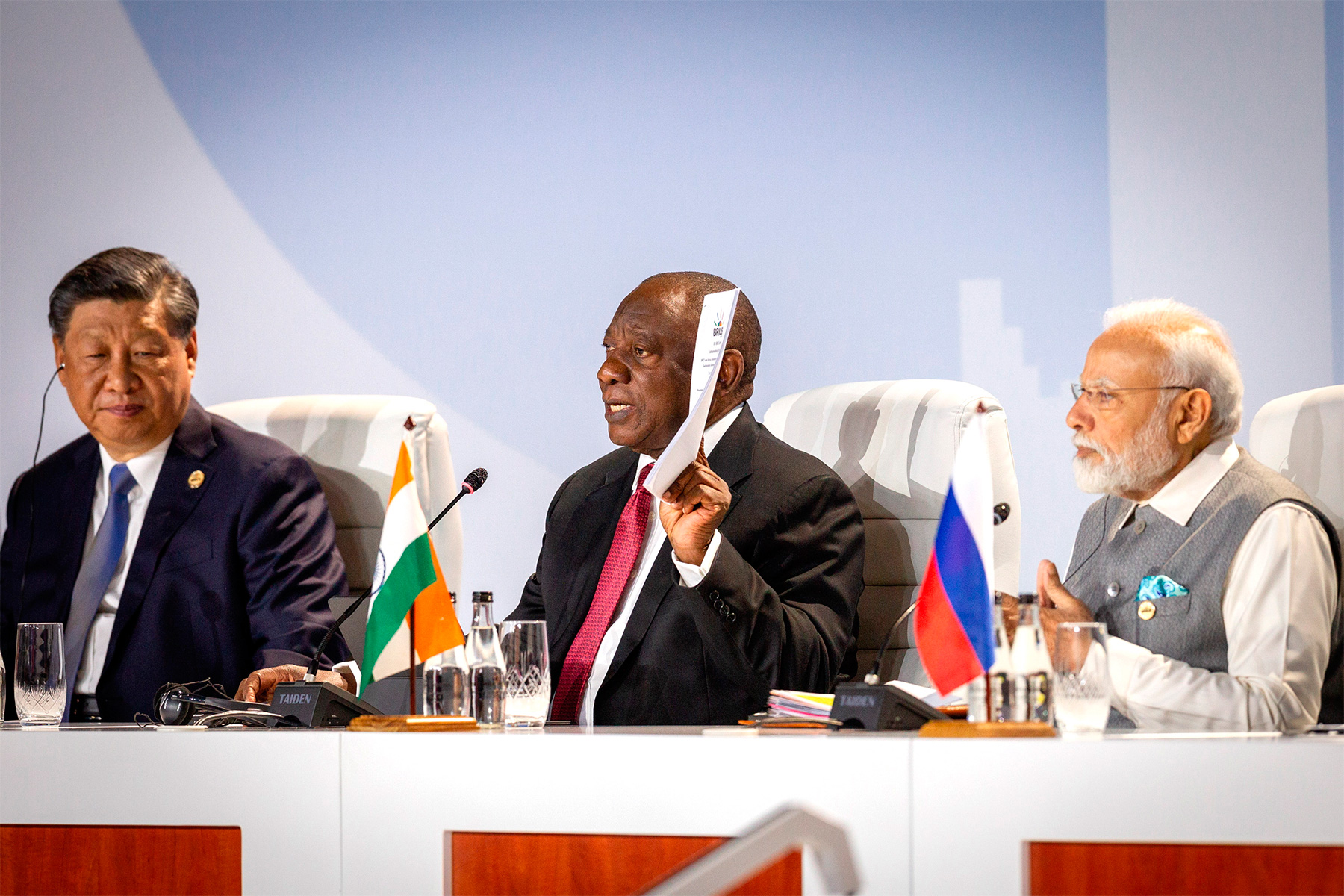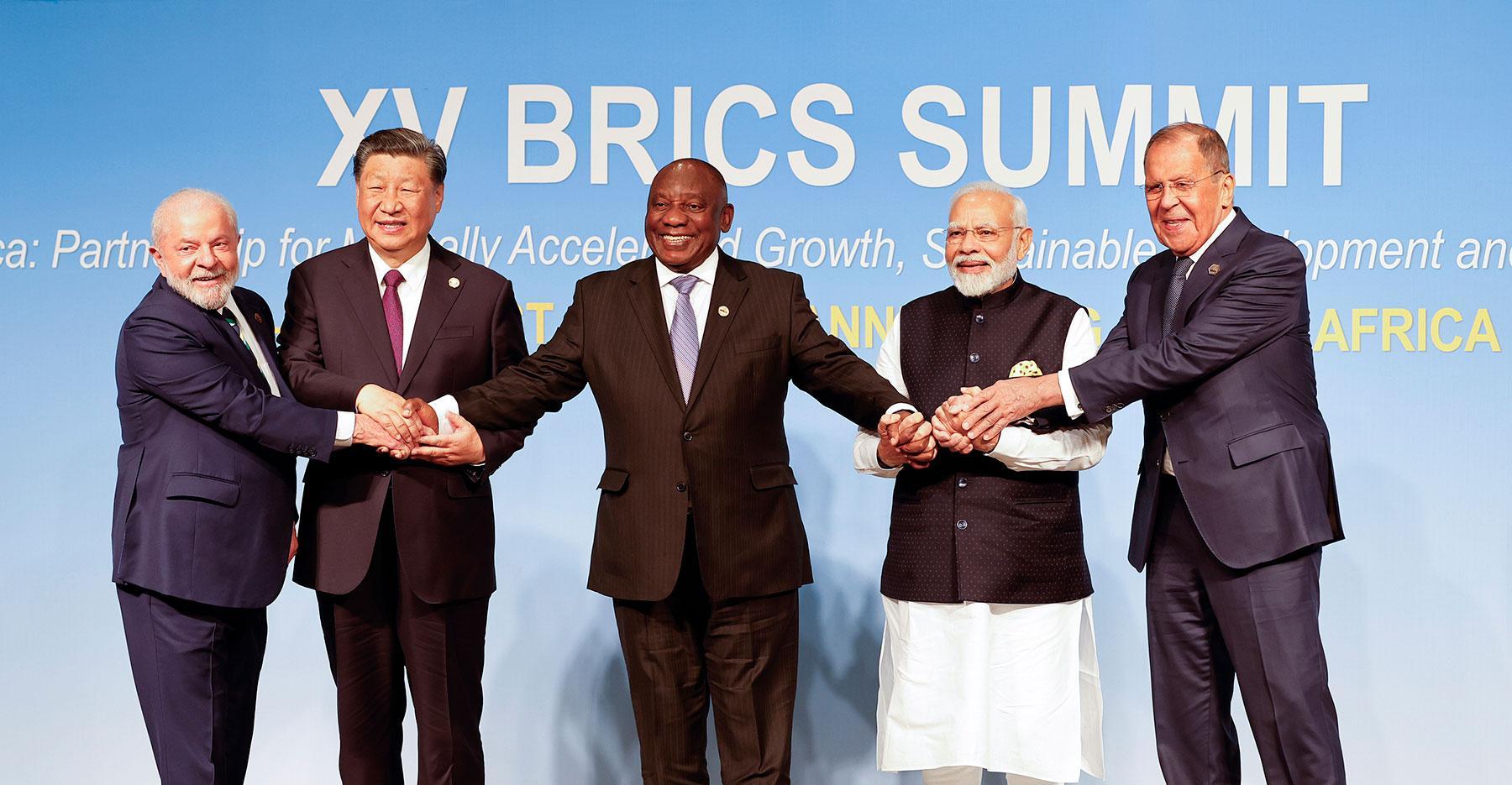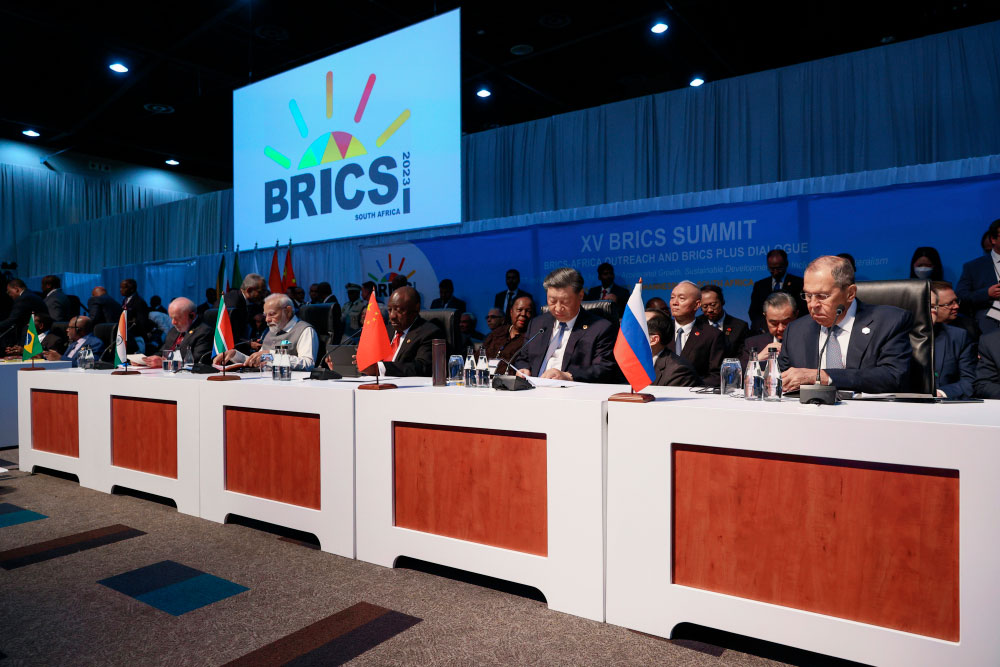Institutionalization of BRICS: From Literature Review to Making Reality
In
Login if you are already registered
(votes: 4, rating: 5) |
(4 votes) |
BS, University of Rome, Tor Vergata
The alliance, at its current stage, represents an informal intergovernmental organization, and thus can become formal with further institutionalization processes. A wide range of considerations were given to the theoretical framework of institutionalization. Briefly, the literature review was proposed to consider various views on the BRICS placement, both in its institution-building processes and general South-South cooperation structure. Further, the article considered existing cooperation mechanisms that could serve as the basis for institutionalization, such as the BRICS Parliamentary Forum or the BRICS Digital Economy Working Group. The ASEAN transition to a formal international body was considered a potential model, mainly due to its similarities with the BRICS features, such as consensus decision-making processes or a rigid non-interference position. Some relevant input was made when compared to the GCC. Finally, a unique institutional structure was proposed. Other scholars could contribute to the analysis by considering an alternative functional institutional cooperation on a case-by-case basis, or drawing comparisons with other organizations that have undergone institutionalization.
Special attention should be drawn once again to the purposes of such an alliance. To ensure a truly multipolar world, the countries of the Global North should be invited to engage with the group in various fields and be a part of the decision-making power, but with a careful consideration of all parties’ interests at stake. Among other recommendations, some authors draw attention to peer learning promotion, grassroots civil society dimension expansion, and R&D expenditure.
In terms of horizontal institution-building, special attention should be given to determining sectoral sub-organs. The main areas of cooperation could be traced through the group’s declarations and summits’ orientation. Thus, from this standpoint, one could consider potential organs that could be established. To name the most visible ones, the division could be done along the main three spheres: a) political-security, b) financial-economic, and c) socio-cultural — all in accordance with the core BRICS values and principles of sustainable development.
As BRICS becomes more grounded, the question arises as to what kind of institutionalization the
group needs to make it more effective and to give it more content.
Suresh P. Singh and Memory Dube
With the group’s expansion, the need for institutionalization and apparatus-creation has seemingly become more visible. For the purposes of the article, institutionalization is defined as “the act or process of establishing a group, movement, program, etc., as a permanent and publicly recognized entity for the promotion of a particular cause”. This process of institution-creation is considered crucial for structure provision and result delivery. Therefore, for the group’s ambitions to be attained, one has to consider some of the obstacles lying on the way to a successful institutionalization, and further propose its own unique structure. The article goes as follows: it starts off with a literature review, moving on to an analysis of the existent and similar-to-BRICS institutions, to give further consideration of the BRICS specificities as an alliance.
Prominent scholars made various suggestions regarding the group’s institutionalization practices, the main of which refers to the establishment of the NDB and the CRA as “the first successful attempt to institutionalize the group”, or “a major step towards the institutionalization of an economic agenda”. However, for the clear creation of the institution, one has to be thoughtful of the kind of institution in question. In 2014, in light of the 6th BRICS Academic Forum, the Institute of Applied Economic Research (IPEA) shared a brief description of the alliance: “As a group, BRICS has an informal character. There is no charter, it does not work with a fixed secretariat, nor does it have any funds to finance its activities. Ultimately, what sustains the mechanism is the political will of its members. However, BRICS have a degree of institutionalization which is defined as the five countries intensify their interaction.” Moreover, with the current BRICS features, the alliance is often compared to the G7, “an informal grouping of advanced democracies that meets annually to coordinate global economic policy and address other transnational issues”, and quite similarly lacks any legal or institutional basis. Such a linkage is understandable due to a very similar informal structure, encompassing the following: annual Summits of the Heads of State and Government with a rotating presidency, ministerial meetings, and working groups, among others. Despite frequent comparisons, BRICS representatives underline: “We do not want to be a counterpoint to the G7, G20 or the United States”. Furthermore, the group’s functionality scope has expanded both in width and depth; the nature of the alliance encompasses a unique feature combination and claims for South-South cooperation; and the group’s expansion has become a promising factor for its role in the international arena. Therefore, despite not being a formal intergovernmental organization (IGO), the prerequisites for such a tendency exist. Thus, for the purposes of the article, the BRICS alliance is defined as an informal intergovernmental organization that naturally requires further institutionalization for a higher level of operationalization and functionality.

The 2023 “Expansion Summit”: BRICS+ History in the Making
“Informal institutionalization, characterized by a preference for informal arrangements premised on convention and mutual understanding rather than formal rules, sets clear limits for potential actorness”, said Dr. Jens-Uwe Wunderlich. The author continues: “In contrast, more formalized institutionalization enhances internal cohesion and representation in international affairs.” Therefore, the institution-building process impacts international actorness in various ways: “First, it determines issues of representation. Second, it influences internal cohesion through a culture of rules, norms and compliance mechanisms. And third, it defines decision-making processes and the articulation of collective interests.” Furthermore, it is crucial to underline the institutional deficiencies identified in the capability-expectations gap (CEG) by Christopher Hill. Commenting on the concept creation, the author indicates the “gap between capabilities and expectations [was] seen as the significant difference which had come about between the myriad hopes and demands of the EU as an international actor, and its relatively limited ability to deliver”. Drawing comparison with the BRICS development over time, it could be argued that the CEG, comprised of resources, instruments and cohesiveness on the one hand, and internal and external expectations on the other, has been narrowing due to the growing range of capabilities and a proportionate expectation level. Despite some authors arguing that informal organizations provide for a degree of flexibility and adjustment and are therefore more appealing to some actors, all these arguments attest to the importance of institutionalization.
An article argues for the three main features to be predominant in institution identification, namely: a) deliberation system, “institutional spaces where the states carry out the negotiation process in order to establish an agreement or consensus”, b) informational system, “the set of rules and regulations aimed to solve and regulate the information flows that are institutionally produced”, and c) institutional incentive system, “the set of norms and rules that regulate the behavior of the actors in order to induce certain behaviors and discourage others”. Regarding BRICS, institutional practices are comprised of deliberation spaces such as annual executive summits, ministerial meetings, mainly in the areas of finance, foreign affairs, or health, technical-bureaucratic meetings, either autonomous or delegated, and people-to-people contacts. Further, the paper notes the importance of Declarations as the main outcome within the informational system domain. Finally, institutional incentives are provided, among which the economic and financial ones are largely represented by the NDB and CRA establishment. The author concludes that intergovernmentalism to predominates the members’ relations, underlining they “[...] have not waived sovereignty of any kind before BRICS’ organizations, but have sought to establish common norms and rules that allow them to achieve the necessary consensus without having to resign sovereign competence on the way.” Indeed, the most common view regarding BRICS institutionalization suggests that the processes have already started with the establishment of the New Development Bank (NDB) and the Contingent Reserve Arrangement (CRA). Another study considers the degree of the group’s institutionalization within the framework of its outreach, or “collaborative interaction among the BRICS actors [...] and other actors within and outside the BRICS area”. The study suggests that “the institutionalization of the BRICS outreach is a function of the cohesion of the BRICS outreach strategy, which in turn is linked to the overall political cohesion of BRICS”, and concludes that distrust, divergence, and the group’s relatively immature nature are the main consolidation obstacles. Significantly, the NDB “presents a stronger degree of outreach institutionalization and [...] political cohesion within the thematic domain of infrastructure financing”. On a contrary, a report by the National Committee for BRICS Research argues for the alliance to be “a consolidating core of rising civilizations and powers”. Further, the paper assumes: “This involves the institutionalization of the BRICS as a full-featured intercivilizational union with the General Secretariat, with the interaction between the executive, legislative and sectoral bodies, scientific, educational and informational base, relying on a system of interstate agreements.”
A research paper proposed four possible forms of the group’s institutionalization:
- conservative — development of institutionalization processes along the traditional path of cooperation expansion,
- more active development of bilateral relations and the use of the best bilateral practices to create new multilateral interaction mechanisms within the BRICS framework,
- more active interaction of individual BRICS participants within the framework of other international organizations to which they are part of, and the subsequent implementation of such mechanisms within the BRICS alliance, and
- creation of new institutions that would have a multiplier effect on the group’s development (i.e. the NDB).
This article suggests all the aforementioned forms of institutionalization processes can be present and interwoven within the BRICS alliance. Commenting on the institutionalization perspectives, another article proposes a mainstream horizontal integration model in which no rigid subordination or integration interdependence exists, therefore corresponding to the main principles of multipolarity creation. Gleb Toropchin mentions the lack of official institutionalization, further highlighting: “Nonetheless, in practice, principles of the existence of BRICS have already been defined de facto, entreching them is the next step in this direction.”

Impulse of Multipolarity: Outcomes of South Africa’s BRICS Summit
Indeed, there is a substantial degree of existing operationalization mechanisms that could become the group’s institutional basis. The BRICS Parliamentary Forum’s mission “is to intensify concerted efforts to address mutual concerns and to persistently strengthen the inter-parliamentary relations of BRICS Member States, underscoring the fact that robust parliamentary cooperation is fundamental to the essence of BRICS cooperation”. Indeed, the Federation Council of the Federal Assembly of the Russian Federation published a note after the XV BRICS Summit, where it stressed its support for “further efforts towards a more inclusive BRICS, institutionalization of its parliamentary dimension, and expansion of people-to-people contacts”. Ministerial and High Representatives meetings become a more recurrent feature within this intergovernmental organization, allowing the actors to exchange views on major global and regional issues. Furthermore, a complex nature of cooperation already exists in separate spheres and can be traced in the content of the group’s annual declarations. In the security sphere, the nations recall their determination for peace and development under the “African solutions to African problems” principles, the reestablishment of diplomatic relations between the Kingdom of Saudi Arabia and the Islamic Republic of Iran, the promotion of a lasting settlement to the Syrian crisis, and many others. In the same sphere, the call for strengthening disarmament and non-proliferation is often made. Furthermore, counter-terrorism measures remain of high significance. On the economic frontier, one could recall the Strategy for BRICS Economic Partnership 2025, the Strategy on Food Security Cooperation of the BRICS countries, the BRICS Digital Economy Working Group, the BRICS Partnership on the New Industrial Revolution (PartNIR), and many others. Numerous documents were signed in the spheres of finances, trade and innovation, such as the BRICS Understanding on Investment Facilitation, the Memorandum of BRICS DFIs Principles for Responsible Financing, and the Memorandum of Understanding Among BRICS Trade and Investment Promotion Agencies (TIPAs)/Trade Promotion Organizations (TPOs), among others. Furthermore, special attention is given to sustainable development, in which the principle of Common but Differentiated Responsibilities and Respective Capabilities (CBDR-RC) is reaffirmed. Finally, the BRICS Academic Forum, the BRICS Think Tank Council, and the general work of the BRICS Working Group on Culture are some of the examples in the cultural sphere of “people-to-people” cooperation. Thus, the working scope of the alliance is broad and requires a more coordinated operationalization mechanism, especially in light of the group’s expansion. Below, theoretical and practical criteria are combined to propose a BRICS institutional structure.
Considering theoretical framework, IGOs are created through multilateral treaties “that act like a constitution in that the states parties are consenting to be bound by the treaty that sets up the agencies, functions, and purposes of the organization”. Further, an IGO requires a legislative body that will create legal acts and thus bind its members under international law, an executive body that will facilitate its operationalization, and a dispute resolution mechanism. The general structure consists of “a small executive council, a plenary assembly in which all members are represented [...], a secretariat that performs the day-to-day administrative activities of the organization, and subsidiary organs that perform special functions”.
Considering practical implications, one could draw comparisons with intergovernmental organizations that have undergone institutionalization. Alice D. Ba explores ASEAN institutionalization practices and argues for a more unconventional understanding, in which “some of the most durable (“institutionalized”) practices are not products of such legal or centrally enforced structures at all, but rather the discipling norms and social conventions of a given community”. The author further underlines the importance of the non-interference principle reflected in the nature of cooperation, not “necessarily harmonized in the sense of standardization or homogenization”. Further, Alice D. Ba comments: “Consensus decision-making contrasts with majority-rules decision-making, where minority states must subordinate their own concerns to those of the majority. Consensus is about respect for national self-determination and mutual accommodation towards an outcome that all can support.” The lack of binding mechanisms and subsequent non-compliance are named among the deficiencies of such an organizational structure. Alice D. Ba responds that “they nevertheless exert strong regulatory pressures on the kinds of cooperation states are able to pursue” in the region and have to be considered not under the legal and contractual forms of cooperation but in light of institutionalization as “the process by which practices are made more dependable”. Anticipating potential criticism for the group’s heterogeneity and present bilateral disputes and drawing a comparison with the ASEAN countries, keeping bilateral conflicts off the organization’s agenda, or referring to other international organizations for settling disputes is not contrary to its norms and practices. All the aforementioned features could be considered for BRICS institution-building.
The proposals made below assume that the group will decide to deepen its integration processes and become a formal alliance, while at the same time respecting the sovereignty and territorial integrity of each state, thus not imposing any obligatory decisions but rather strengthening already existing institutionalization premises and securing its role in the international arena. Thus, a parallel comparison could be drawn with the ASEAN or Gulf Cooperation Council (GCC), rather than the EU due to the deep integration processes inferring the principle of non-interference strongly present in the latter. The ASEAN Charter, for instance, directly states “respect for the independence, sovereignty, equality, territorial integrity and national identity of all ASEAN Member States” and “non-interference in the internal affairs of ASEAN Member States”. Importantly, Article 5.2 mentions “the enactment of appropriate domestic legislation, to effectively implement the provisions of this Charter and to comply with all obligations of membership”. Thus, Charter creation would be seen as the first step towards institutionalization and would allow the organization to obtain a legal personality, enhance institutional accountability and compliance, and reinforce the role of the BRICS as a serious international actor. Then, the processes could take on various modalities. In terms of structural integration, the main decision-making organ could comprise all the member states on an equal footing in the form of the Head Commission and thus enshrine the consensus principle. Drawing parallels with the GCC Supreme Council, it “shall be formed of heads of member states”, and “its presidency shall be rotatory based on the alphabetical order of the names of the member states”, clearly resembling the BRICS Summits organizational structure. Similarly, the functions of the ASEAN Summit (Article 7 of the Charter), such as policy guidance provision, ministerial instructions, and emergency situations addressed, among others, could be enshrined in the functionality width of a similar BRICS Summit organ. The potential legislative branch could be represented in the form of the BRICS Parliament and Ministerial Council. Again referring to the GCC Charter, the functions of such an organ would consist of, but not be limited to, the following: “Propose policies, prepare recommendations, studies and projects aimed at developing cooperation and coordination between member states in various fields and adopt the resolutions or recommendations required in this regard.” For the betterment of administrative coordination, the BRICS Secretariat, constructed of independent national secretariats, could be appointed. Finally, the Commission for Dispute Settlement is to be established for the provision of intra-conflict dispute resolution mechanisms.

BRICS Cooperation Mechanism Gives Hand to Global South
In terms of horizontal institution-building, special attention should be given to determining sectoral sub-organs. The main areas of cooperation could be traced through the group’s declarations and summits’ orientation. Thus, from this standpoint, one could consider potential organs that could be established. To name the most visible ones, the division could be done along the main three spheres: a) political-security, b) financial-economic, and c) socio-cultural — all in accordance with the core BRICS values and principles of sustainable development. These main organs should each have an organizational structure with agreed-upon full consensus principles and guidelines. To avoid the creation of just another organization, more proactive and substantive measures could be taken in each field. For instance, the establishment of a counterterrorism working group in a region prone to high levels of terrorist acts, merging efforts with the African Union and Caribbean Community (Caricom) for the establishment of a reparation fund, or easing visa requirements and procedures among the allied countries. In addition to the main sub-organs, a special body coordinating regional efforts could be put in place. An important role in the XV BRICS Summit was dedicated to the African Continental Free Trade Area (AfCFTA). Importantly, BRICS member states encompass a large network of regional organizations such as the Eurasian Economic Union (EAEU), Shanghai Cooperation Organization (SCO), Southern Common Market (MERCOSUR), African Union (AU), and South Asian Association for Regional Cooperation (SAARC), thus creating some sort of BRICS Plus or BRICS Outreach alliance, which also should be coordinated for the betterment of its efficiency. Importantly, monitoring and evaluation mechanisms should undergo strict scrutiny at every level of operations to avoid mismanagement due to the large working scope of the organization and its organs. “There is a need for target-driven and time-bound deliverables accompanied by appropriate measures and mechanisms for delivery and implementation that are tied to adequate monitoring systems”, noted Suresh P. Singh and Memory Dube on the “definite way of cementing the institutionalization of BRICS”.
Special attention should be drawn once again to the purposes of such an alliance. To ensure a truly multipolar world, the countries of the Global North should be invited to engage with the group in various fields and be a part of the decision-making power, but with a careful consideration of all parties’ interests at stake. Among other recommendations, some authors draw attention to peer learning promotion, grassroots civil society dimension expansion, and R&D expenditure.
There is no agreement regarding the definition of the group. The article determined that the alliance at its current stage represents an informal intergovernmental organization, and thus can become formal with further institutionalization processes. A wide range of considerations were given to the theoretical framework of institutionalization. Briefly, the literature review was proposed to consider various views on the BRICS placement, both in its institution-building processes and general South-South cooperation structure. Further, the article considered existing cooperation mechanisms that could serve as the basis for institutionalization, such as the BRICS Parliamentary Forum or the BRICS Digital Economy Working Group. The ASEAN transition to a formal international body was considered a potential model, mainly due to its similarities with the BRICS features, such as consensus decision-making processes or a rigid non-interference position. Some relevant input was made when compared to the GCC. Finally, a unique institutional structure was proposed. Other scholars could contribute to the analysis by considering an alternative functional institutional cooperation on a case-by-case basis, or drawing comparisons with other organizations that have undergone institutionalization
(votes: 4, rating: 5) |
(4 votes) |
Why BRICS has become the hero of the day, while the G7 remained at the back seat
The 2023 “Expansion Summit”: BRICS+ History in the MakingA key area of focus in the coming years should also be the expansion in the mandate of the BRICS New Development Bank as well as the BRICS Contingency Reserve Arrangement (CRA)
BRICS Cooperation Mechanism Gives Hand to Global SouthThe BRICS might be a suitable place to formulate new approaches to the Internet governance system reform, since the discussion on its key aspects (cybersecurity in particular) stagnates




